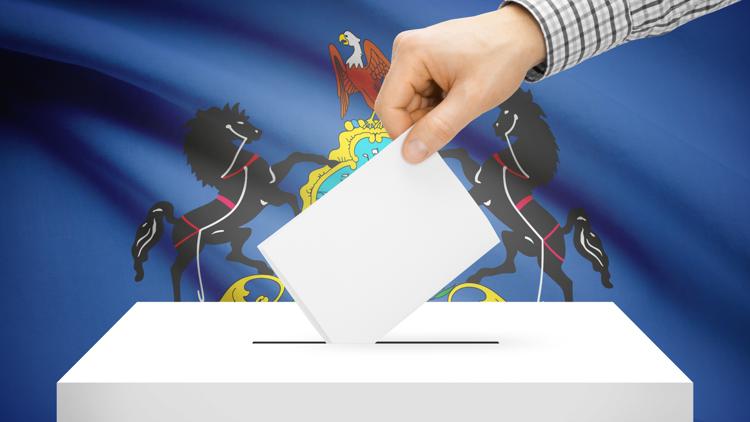PENNSYLVANIA, USA — Pennsylvania, a perpetual swing state, is home to two of the most closely watched races in the country this fall.
The contest to succeed term-limited Democratic Gov. Tom Wolf pits GOP state Sen. Doug Mastriano, a staunch supporter of former President Donald Trump’s attempt to overturn his election loss, against second-term state Attorney General Josh Shapiro, a Democrat who played a prominent role in fighting Trump’s litigation over the 2020 contest.
In the U.S. Senate, Republican Sen. Pat Toomey is retiring after two terms. In the close contest to replace him, television celebrity Dr. Mehmet Oz is running against Wolf’s lieutenant governor, Democrat John Fetterman.
The state’s congressional delegation, which has been evenly divided in recent years, lost a seat because of redistricting. The most competitive races for the U.S. House are for seats in Scranton and Allentown, where incumbent Democratic Reps. Matt Cartwright and Susan Wild are in rematches with Republican opponents who came close to beating them two years ago, and in suburban Pittsburgh, where an open seat consists in great part of the remnants of the district held by retiring Rep. Conor Lamb, a Democrat.
Redistricting also made wholesale changes to the district maps in the state Legislature, where Republicans are hoping their solid majorities in both chambers will survive and keep them in control of the legislative branch.
Here’s a look at what to expect on election night:
ELECTION NIGHT
Polls close at 8 p.m. ET.
Get the latest results at wnep.com/election.
Find your polling place, drop box locations and more at wnep.com/vote.
HOW PENNSYLVANIA VOTES
Pennsylvania greatly expanded mail-in voting in late 2019, just before the pandemic hit, allowing it for nearly anyone. But county election workers can’t start to process those ballots until the morning of the election. In 2020’s presidential election, the protracted counting of an unforeseen flood of mail-in ballots stretched for four days before news organizations could call the race for Joe Biden in Pennsylvania.
Since then, counties have had more experience with counting mail-in ballots, they have more resources to handle the task and fewer voters are casting mail-in ballots than during the peak of the pandemic. State election officials are cautioning that it may still take a few days to complete the count, although officials in Philadelphia and in the most heavily populated counties expect to finish the bulk of the counting the following morning.
Democrats tend to do well in the big cities, Philadelphia and Pittsburgh, and have recently made gains in Philadelphia’s fast-growing suburban “collar” counties of Bucks, Montgomery, Delaware and Chester, as well as Pittsburgh’s inner-ring suburbs in Allegheny County.
Republicans have taken control in many counties outside of metropolitan Pittsburgh in western Pennsylvania where white voters once backed Democrats, as well as areas outside the cities of Scranton and Wilkes-Barre in northeastern Pennsylvania. The Lehigh Valley — Lehigh and Northampton counties, which include Allentown and Bethlehem — have performed as a bellwether region.
WHAT ELSE SHOULD I KNOW?
Q: WHAT DID WE LEARN FROM THE PRIMARY?
A: Mastriano’s win showed strong support from religious conservatives and Trump’s most devoted supporters in a low-turnout, nine-candidate election where under 40% of Republicans voters cast ballots. Shapiro was unchallenged, as he consolidated backing from the state’s Democratic Party establishment, labor unions and top donors, bringing a reputation as a strong fundraiser and the biggest single voter-getter in the state’s history.
Fetterman beat Lamb for the Democratic nomination and showed strong grassroots support for a man who has been a progressive star, a force in fundraising and an unconventional candidate who has aimed to bring alienated voters back into the party’s fold.
The biggest question hovering over Fetterman is what voters will make of his recovery from a stroke earlier this year that he says nearly killed him. The election comes barely two weeks after he had a shaky showing in his sole debate against Oz, struggling to complete sentences, jumbling words and fueling concerns in the party about his candidacy. However, he has since delivered a number of smooth speeches in campaign appearances around the state.
Oz, a heart surgeon who has treated stroke patients, has questioned whether Fetterman has been honest about the effects of the stroke and suggested that it has left Fetterman unequipped to serve in the Senate.
Oz showed durability after sustaining more than $20 million in attack ads in the primary. He edged out hedge fund executive Dave McCormick by about 950 votes after a statewide recount. But attack ads that portrayed him as a liberal Hollywood elitist helped leave conservative voters wary of him. He also lacks deep political roots in the state, having moved from New Jersey to run, a favorite topic for the Fetterman campaign. But we also learned that Oz has plenty of resources: He has spent more than $20 million of his own money on his race.
Q: WHAT’S CHANGED SINCE THE PANDEMIC ELECTION OF 2020?
A: A new law allocated $45 million to counties to help them handle the task of counting mail-in ballots. Just four of 67 counties did not apply for the money. The legislation appropriating the money also said that counties receiving those election grants should count ballots “without interruption” — an effort to speed up the processing of mail-in ballots and avoid a protracted post-election count. Those counties also must report by midnight on election night how many mail ballots they received.
Q: WHAT DO TURNOUT AND ADVANCE VOTE LOOK LIKE?
A: As of Oct. 27, more than 1.35 million voters had requested mail ballots for the election, according to state elections officials. About 70% were requested by registered Democrats and about 20% by Republicans. Just over 738,000 had been returned.
Q: HOW LONG DOES COUNTING USUALLY TAKE?
A: Vote counting typically extends for several days. In 2020, counties reached 90% of statewide votes counted on Thursday evening — a full two days after polls closed. That year, the AP called the presidential race in Pennsylvania on Saturday, four days after the election. This year, the most heavily populated counties expect to report the bulk of their counting done by Wednesday morning.
Q: WHAT ARE THE PITFALLS WITH EARLY RETURNS?
A: More Democrats than Republicans vote by mail in Pennsylvania. State law dictates that mail ballot processing cannot begin until Election Day, meaning the complete counting of those ballots tends to take longer than the count of ballots cast on polling place machines.
In recent elections, that has meant that votes counted later in the process have been more likely to favor Democrats. That skews election night counts toward Republicans, and ballots counted in the hours after that tend to heavily favor Democrats, creating a dynamic where Republicans may lead heavily on election night in races but see that lead shrink or disappears hours or days later.
Q: WHAT HAPPENS AFTER TUESDAY?
A: Beyond the mandatory recount threshold of 0.5%, candidates cannot request a recount under state law. But three “qualified electors” from each contested district can request a recount no matter the margin. The petitioner has to pay for it. Those provisions have made such recounts rare.



